Miso soup, katsu sandwiches, baked salmon: Simple Japanese-inspired recipes from Cibi
Updated , first published
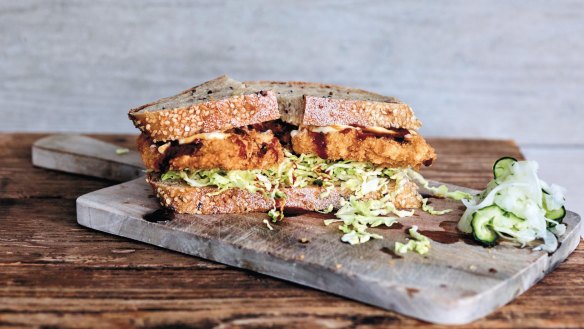
Meg and Zenta Tanaka opened Cibi, a multipurpose cafe, store, event and neighbourhood space in Collingwood in 2008.
These recipes reflect Cibi's signature style: a blend of traditional Japanese ingredients and cooking methods with Western flavours and seasonal produce.
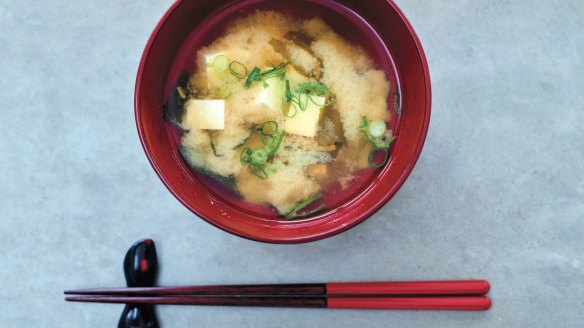
My grandma's miso soup
We serve it as part of our Japanese breakfast – it's exactly what I used to eat when I was a kid. My grandma grows her own vegetables, and adds whatever is in season to the soup to make it wholesome and tasty.
INGREDIENTS
100g onion, finely sliced
70g carrot, cut into thin strips
150g potato, peeled and cubed
80g daikon (white radish), cut into thin strips
1 litre (4 cups) dashi (see recipe below)
100g silken tofu, cubed, or 30g Japanese bean curd, cut into thin strips
60g white or red miso
2 tbsp dried wakame seaweed, soaked and drained
2-3 tbsp finely chopped spring onion
50g snow peas, trimmed, blanched and finely sliced
METHOD
1. Add the onion, carrot, potato and daikon to the dashi and cook over a medium heat for about 10 minutes, until the vegetables become soft. Add the tofu or bean curd.
2. Turn the heat off, then add the miso using a miso koshi or a fine-mesh strainer to ensure the miso is blended evenly. Simmer the soup on a low heat, turning it off just before it starts to boil.
3. Distribute the wakame and spring onion into individual soup bowls. Pour the miso soup over the top and arrange the snow peas on top.
Serves 4
TIP Don't let your miso soup heat to above 95C – boiling miso soup is detrimental to its flavour. The best temperature at which to eat it is around 75C.
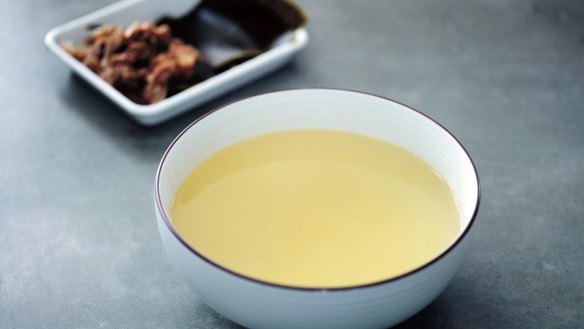
Dashi
Other classic Japanese dashi add-in options are dried shiitake mushrooms and niboshi (small dried anchovies). To make vegetarian dashi, leave out the bonito flakes.
INGREDIENTS
10 x 5cm piece of kombu
about 1 handful (7-8g) bonito flakes
METHOD
1. Combine 1 litre water and the kombu in a large saucepan and simmer over a low heat. Just before the water starts to boil, remove the kombu.
2. Add the bonito flakes to the saucepan. Cook over a low heat for two minutes and gently skim any foam from the surface using a fine-mesh strainer. Don't stir – doing so will make it bitter.
3. Turn off the heat and strain the stock through a fine-mesh sieve into a bowl. Discard the bonito flakes. Dashi will keep in the fridge for two days, and can be frozen in resealable bags.
Makes about 1 litre.
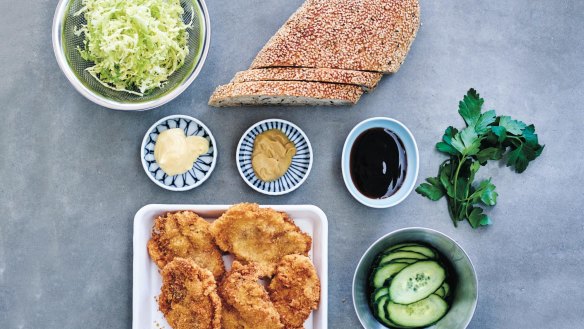
Katsu sandwich with pickled fennel and cucumber
Everyone loves tonkatsu (pork katsu), the Japanese version of schnitzel. I like to use pork hire-niku (fillet) rather than ro-su (loin) as fillet katsu is tender and has less fat. In this sandwich, it's served alongside fennel and cucumber pickled in a sweet-sour amazu dressing.
INGREDIENTS
¼ medium savoy cabbage
2 tbsp chopped flat-leaf parsley
300g pork fillet
100g plain flour
1 egg
300g panko breadcrumbs
oil, for deep-frying
2 tbsp dijon mustard
8 slices seeded sourdough
¼ telegraph cucumber, sliced
60ml (¼ cup) Japanese tonkatsu* or worcestershire sauce
2 tbsp Japanese mayonnaise
Pickled fennel and cucumber
1 fennel, cut in half and finely sliced
¼ cucumber, sliced
60ml amazu (see recipe below)
METHOD
1. Finely shred the cabbage and soak it in cold water for five minutes, which will make it nice and crunchy. Drain well, then combine it with the parsley and mix well.
2. To make the pickled fennel and cucumber, mix all of the ingredients together and let them marinate for at least 30 minutes.
3. Cut the pork into 40–50g pieces and season with salt and pepper.
4. Sprinkle the flour on a plate, lightly beat the egg in a small bowl and place the panko breadcrumbs on a second plate. To crumb the pork, dip the pieces into the flour, then into the egg, then coat them evenly with breadcrumbs.
5. Heat the oil in a deep-fryer or large, heavy-based saucepan (fill the pan to a depth of about 5cm) until it reaches 170C when tested with a cooking thermometer. Deep-fry the pork for about five minutes, until crisp and light brown. Transfer the pieces to a wire rack with paper towel underneath to catch excess oil.
6. Spread the dijon mustard on four slices of sourdough. Arrange some cabbage on top of each, then 3-4 slices of cucumber and 2-3 pieces of pork. Dollop some tonkatsu sauce on top. Spread the mayonnaise on the last four slices of bread and assemble the sandwiches. Serve with the pickles on the side.
*Tonkatsu sauce is available from Japanese or Asian grocers, or from large supermarkets.
Makes 4 sandwiches
Amazu
INGREDIENTS
200ml rice vinegar
40g sugar
½ tsp salt
METHOD
1. In a small bowl, combine the ingredients and mix well.
Makes 260ml
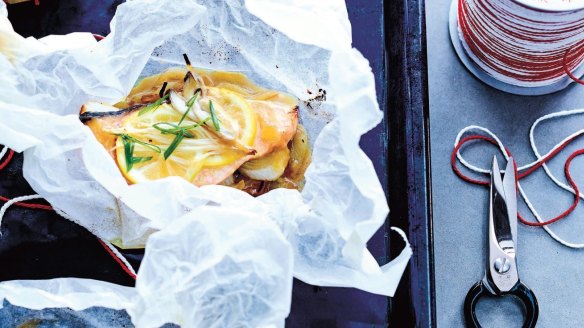
Baked salmon with autumn mushrooms and sweet miso sauce
I used to help my mum make this dish when I was little. We had no baking tray at home in those days, as baking wasn't so common. Instead, it was fun to wrap the fillets in individual pieces of foil, bake them one by one and serve them with a little cube of butter and a slice of lemon on top. My family considered it a very "high-end" Western dish, but I've added sweet miso sauce for an Eastern touch. I bake the salmon with mushrooms, but you can use other vegetables such as fennel, zucchini, capsicum or tomato: whatever flavour combination you like!
INGREDIENTS
½ leek, sliced into 5 mm pieces
1 medium onion, cut in half and thinly sliced
4 x 90-100g salmon fillets
3 tbsp sweet miso sauce (see recipe)
8 thin lemon slices
100g shimeji mushrooms*
50g enoki mushrooms*
20g salted butter
1 tbsp finely sliced spring onion, to garnish
juice of ½ lemon, to garnish
METHOD
1. Preheat the oven to 200C.
2. Cut out four 30 x 30cm squares of baking paper.
3. Divide the leek and onion between the four squares, then lay the salmon pieces on top. Pour a little miso sauce over each piece of salmon, then top with the lemon slices, mushrooms and butter. Close each parcel, tying it together with kitchen string.
4. Transfer the parcels to a baking tray and bake for 15 to 20 minutes.
5. Plate the parcels, cut them open, then garnish with spring onion and lemon juice. Serve immediately.
* You can buy many different kinds of Japanese mushrooms: shimeji, enoki, eringi (king oyster), maitake (oyster), shiitake, etc. The texture and flavour of shimeji and enoki are great for this dish, but button or brown mushrooms are good substitutes if you can't find the former.
Serves 4
INGREDIENTS
90g white miso
90ml mirin
60g sugar
METHOD
1. In a small bowl, combine the ingredients and mix well.
Makes 240ml
This is an edited extract from Cibi, by Meg & Zenta Tanaka, published by Hardie Grant Books RRP $50.00 and is available in stores nationally.
Appears in these collections
From our partners
Original URL: https://www.watoday.com.au/goodfood/simple-japanese-inspired-meals-from-melbournes-cibi-20180328-h0y39r.html